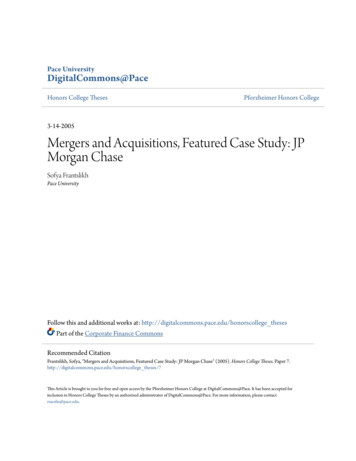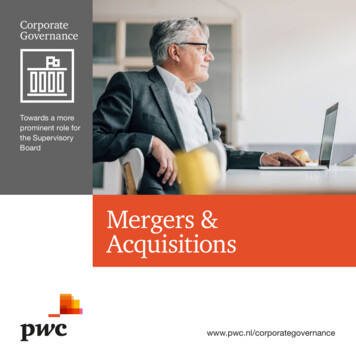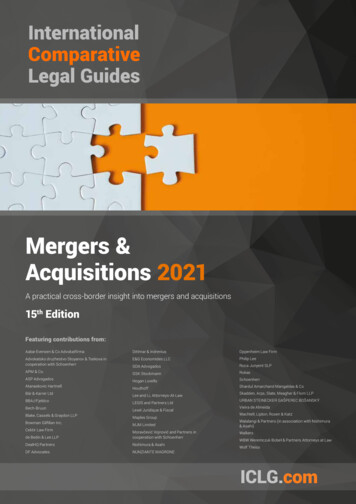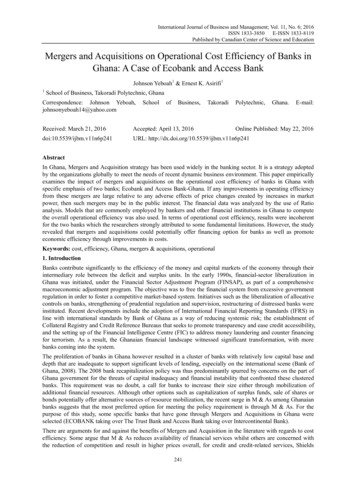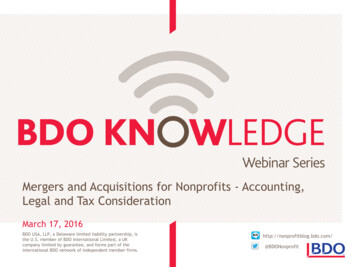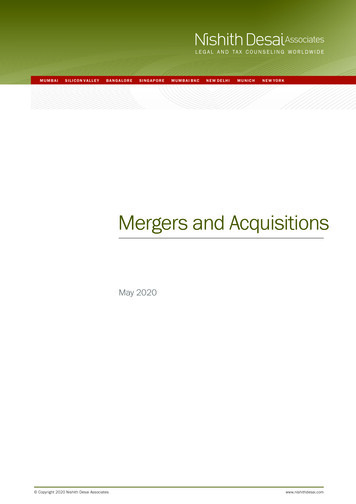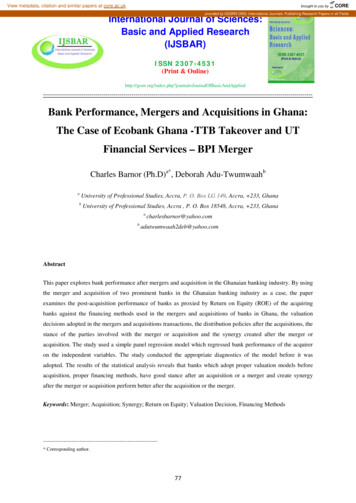
Transcription
View metadata, citation and similar papers at core.ac.ukbrought to you byCOREprovided by GSSRR.ORG: International Journals: Publishing Research Papers in all FieldsInternational Journal of Sciences:Basic and Applied Research(IJSBAR)ISSN 2307-4531(Print & Online)http://gssrr.org/index.php?journal --------Bank Performance, Mergers and Acquisitions in Ghana:The Case of Ecobank Ghana -TTB Takeover and UTFinancial Services – BPI MergerCharles Barnor (Ph.D)a*, Deborah Adu-TwumwaahbaUniversity of Professional Studies, Accra, P. O. Box LG 149, Accra, 233, GhanabUniversity of Professional Studies, Accra , P. O. Box 18548, Accra, 233, o.comAbstractThis paper explores bank performance after mergers and acquisition in the Ghanaian banking industry. By usingthe merger and acquisition of two prominent banks in the Ghanaian banking industry as a case, the paperexamines the post-acquisition performance of banks as proxied by Return on Equity (ROE) of the acquiringbanks against the financing methods used in the mergers and acquisitions of banks in Ghana, the valuationdecisions adopted in the mergers and acquisitions transactions, the distribution policies after the acquisitions, thestance of the parties involved with the merger or acquisition and the synergy created after the merger oracquisition. The study used a simple panel regression model which regressed bank performance of the acquireron the independent variables. The study conducted the appropriate diagnostics of the model before it wasadopted. The results of the statistical analysis reveals that banks which adopt proper valuation models beforeacquisition, proper financing methods, have good stance after an acquisition or a merger and create synergyafter the merger or acquisition perform better after the acquisition or the merger.Keywords: Merger; Acquisition; Synergy; Return on Equity; Valuation Decision, Financing ----------------------------* Corresponding author.77
International Journal of Sciences: Basic and Applied Research (IJSBAR) (2015) Volume 24, No 6, pp 77-911.IntroductionIn the last decade, Ghana’s financial sector has witnessed a lot of mergers and acquisitions which changed theownership structure of banks in Ghana, especially Ghanaian banks from local to expatriate banks. The immensechange of ownership structure of most of these banks, as can be noticed, were motivated by the Bank of Ghana’sregulations concerning the change in banks’ operating in Ghana’s minimum capital requirement. The first majorincrement in the minimum capital requirement of banks came in the year 2008, where the Bank of Ghana set theminimum capital of banks in Ghana at GH 60 million and in 2013, this figure was further increased to GH 120million. The reason for this exercise by the Bank of Ghana was to protect depositor’s funds. After these twoincrement, a lot of banks who could not meet the deadline resorted to mergers and acquisitions in order tocomply with the Bank of Ghana’s regulations. Banks like Intercontinental Bank, Trust Bank of Ghana and BPIwere taken over by Access Bank, Ecobank and UT bank respectively.Mergers and acquisitions are normally used by corporate organizations as a strategy to stay competitive in theirrespective industries. Authors in [1] cited the work of authors in [37] who assert that most organizations adoptsMergers and acquisitions as a strategy to help them stay competitive and take advantage of opportunitiesemanating from the ever changing business environment. Most studies in the area of mergers and acquisitionsaffirms that organizational performance increases after a merger or acquisition. One of such authors is authors in[20] who aver that firms engaging in M&A activities can expect to improve their performance in terms ofoverall economic, financial and operating performance to be better off after the merger. They go further to addthat such expectations are based on the fundamental theory of mergers and acquisitions which claims that thereis a positive gain to both the acquirer and target.Mergers and acquisitions are seen as major financial breakthrough for organizations with financial difficultiesbut that is not always the case. In most cases, mergers and acquisitions permit two businesses with comparativeadvantage in certain fields to join forces and put together their comparative advantages so that they become oneand take a leading control in the industry. Author [26] gives three main reasons for merger and acquisitionstrategy of organizations. The first according to him is to maximize shareholders wealth. Author [20] citedauthor [26] that the first reason is normally achieved when the consolidation leads to a better scale of economiesor scope of economies and (or) there is improved cost reductions (efficiency). The second reason according toauthor [26] is managerial self-interest which author [26] claims they use as a strategy to defending theirauthoritative positions. The last reason, according to authors in [20, 26], consists of various factors which makethe environment more attractive to M&As and these factors includes the changes in banking sector structure, forinstance, increased competition from non-banking competitors and changes in regulations as has been the caseof Ghana for some time now.The general expectation of all mergers and acquisitions is the overall positive impact they normally have on thetarget and the acquirer as one company. The performance of the new company that emerges out of the merger oracquisition is expected to perform well and to stand the test of competition in the industry. In most cases, this isnot always the case. Some companies which have gone through mergers or acquisitions tend out not performingup to expectation and are later merged or acquired by a different acquirer in another merger or acquisition78
International Journal of Sciences: Basic and Applied Research (IJSBAR) (2015) Volume 24, No 6, pp 77-91agreement. This has been happening all over the world and Ghana’s banking industry is no exception. Thefailure is often attributed to improper financing methods used in the merger or acquisition transaction or eventhe valuation decision adopted in the merger or acquisition transaction. According to author [41] acquisitionsfail for different reasons, but one recurrent theme is that acquirers overpay for the target and they overestimateeither the target’s value, the expected synergies associated with the acquisition, or both. Authors in [5] posit thatmany mergers that seem to make economic sense fail because managers cannot handle the complex task ofintegrating two firms with different production processes, accounting methods, and corporate cultures.The study is motivated by the above mentioned problems to investigate into the mergers and acquisitions thathave occurred in the Ghanaian financial sector for the past ten years to evaluate:1.the financing methods used in the mergers and acquisitions of banks in Ghana;2.the valuation decisions adopted in the mergers and acquisitions transactions;3.the distribution policies after the acquisitions;4.the stance of the parties involved with the merger or acquisition and5.the synergy created after the merger or acquisition.This paper defines a company that is acquiring another company as the acquirer and the company beingacquired is the target company.1.1.Scope of StudyThe study limited its scope to two main banks which have been involved in mergers and acquisitions in Ghana.That is, Ecobank – Trust Bank of Ghana’s acquisition and UT bank – Bank BPI’s Merger. There have beenseveral mergers and acquisitions which have taken place in the Ghanaian financial sector during the last tenyears. Prominent among them are the mergers and acquisitions between Ecobank and the Trust Bank, UTfinancial Holdings and BPI, Merchant Bank and Fortis and International Commercial Bank and First Bank ofNigeria (FNB). The criteria used in selecting these two banks is that the merger or acquisition banks selected forthe study should have at least operated for three years after the merger or acquisition and the acquirer should belisted on the Ghana Stock Exchange. The two selected banks happened to be the only banks that met the criteriaused by the study.2.General overview of Ghana’s financial sectorGhana’s financial sector has gone through a lot of restructuring for decades, all geared towards the improvementof the sector to stand the test of global financial competition. Ghana’s financial sector is made up of both banksand non-banking institutions. This study focuses on only the banking industry. Tracing the history of banking inGhana always takes us back to the late 1800s when the first bank to arrive at the shores of the then Gold Coast,now Ghana, British Bank of West Africa (BBWA- now Standard Chartered Bank), established a branch of thebank in Accra and introduced banking business to the people of the then Gold Coast. In the early 1900s (that is,1917), Ghana witnessed the first merger and acquisition in the financial sector when the then Colonial Bank,merged with the Anglo-Egyptian Bank, National Bank of South Africa and Barclays Bank under the name,79
International Journal of Sciences: Basic and Applied Research (IJSBAR) (2015) Volume 24, No 6, pp 77-91Barclays Bank (Dominion Colonial and Overseas). This first merger achieved some successes because beforethe merger, Colonial Bank could not compete keenly with the then BBWA but after the merger, the new bankwhich was formed, Barclays Bank, became very strong and competed with BBWA intensely.In the late 1950s, the Bank of the Gold Coast (now, Bank of Ghana) and the Gold Coast Commercial bank (now,Ghana Commercial Bank) were established so that the government of Ghana’s accounts as well as commercialbanking activities of the citizens of the Gold Coast (now, Ghana) could be managed by a Ghanaian bank and notan expatriate bank as it used to be. When Bank of Ghana came into the scene, they performed the role as aregulator of the banking industry and the banker to the government as well as the issuer of the Ghanaiancurrency after the introduction of the cedi, among other things. In 2002, the Bank of Ghana Act, 2002, Act 612was passed by parliament to give full mandate to the Bank of Ghana to perform its regulation duty with fullautonomy and free from political influence of the government of the day. Bank of Ghana has introduced a lot ofregulations since its inception which are all geared towards protecting the depositor’s funds. In 2008, Bank ofGhana increased the minimum capital requirement of Banks to GH 60 million and this saw a lot of banksmerging and some being acquired by acquirers, who were mainly expatriate banks. Another increment in theminimum capital requirement came in 2013, when the bank of Ghana increased the minimum capitalrequirement from the GH 60 million to GH 120 million. A lot of banks have merged with other banks whilstothers have been acquired by expatriate banks as a financing strategy for meeting the Bank of Ghana’sminimum requirement, whose deadline is in 2016.3.Selective ReviewThis part of the study presents the empirical and theoretical review of some selected literature on mergers andacquisitions.3.1.Overview of mergers and acquisitionsThe general understanding of a merger and acquisition is a combination of two firms as one company where thecompany with the controlling interest is the acquirer and the company which has been acquired is the target. Asput by authors in [29, 32], the main difference between a merger and an acquisition lies in the way in which thecombination of the two companies is brought about. In an acquisition, the acquirer becomes the controller or thenew owner of the acquired company and the old owner(s) die(s) away but in a merger, two companies withcommon interest or size come together under a consensus to form a new company which will be ran by the twocompanies’ combined as one, under the merger agreement. According to author [33], actual mergers of equalsdon't happen very often but rather one company will buy another and, as part of the deal's terms, allow theacquired firm to state publicly that the action is a merger of equals, even if it is technically an acquisition.Author [33] asserts that acquisition often carries negative connotations, therefore, by describing the deal as amerger, deal makers and top managers try to make the takeover more palatable.Variations of mergers and acquisitionsMergers and acquisitions vary in terms of the motives for the merger or the acquisition and this section80
International Journal of Sciences: Basic and Applied Research (IJSBAR) (2015) Volume 24, No 6, pp 77-91considers the various variations of mergers and acquisitions. Some of these varieties include:a.Horizontal mergers: these are combination of two firms in the same line of business as proclaimed byauthor [5].b.Vertical mergers: involves companies at different stages of production where the buyer expands backtoward the source of raw materials or forward in the direction of the ultimate consumer as posited by author [5].c.Conglomerate mergers: involve companies with different unrelated businesses areas. For instance atelecommunication company merging with a bank. According to author [19], conglomerates are usually used asa way to smooth out wide fluctuations in earnings and provide more consistency in long-term growth.Theories of mergers and acquisitionsThere are a lot of theories about mergers and acquisition and this study discusses the notable ones among them.a.Disciplinary mergers theory: This theory suggests that mergers and acquisitions are used as a form ofdisciplinary measure to discipline the managers of target firms who pursue their own selfish interest other thanmaximizing shareholders’ wealth. Managers who pursue their selfish interest tend to create agency problem andwhen this happens, it affects the profitability of the firm. The firm may perform poorly and consequently, theacquirer would take advantage of the poor performance to acquire the target, replace the poor management teamwith a good and efficient ones, who will perform efficiently and effectively to improve upon performance of thetarget company.b.Synergistic mergers theory: This theory is of the view that the acquirer acquires or merges with thetarget in order to achieve efficiency. It stems from the premise that when two firms with similarities inperformance (that is, the acquirer and the target perform well before the merger or acquisition) come together,they perform even better. The synergistic theory thus implies that target firms perform well both before and aftermergers.c.Behavioral and agency theories: These theories on the other hand, view mergers and acquisitions asresulting from investors and/or managers cognitive biases or the inherent conflicts of interests betweenmanagers and investors - author [6].3.2.Empirical ReviewAuthors from different geographical jurisdictions have conducted different studies in the area of mergers andacquisitions and they have come up with so many different and similar findings. This section of the studyreviews some of these findings.Author [15] asserts that a lot of studies in the area of mergers and acquisitions have shown that returns toacquiring firms are zero or negative. Authors [10, 28, 30, 38] found little evidence of efficiency gains frommergers and acquisitions by the acquirer. However, authors in [10] cited the work of author [32] who used abalanced panel of large continuous U.S. manufacturing plants from the U.S. Census Bureau’s LongitudinalResearch Database and found that ownership changes are negatively related to plants’ pre-acquisition labor81
International Journal of Sciences: Basic and Applied Research (IJSBAR) (2015) Volume 24, No 6, pp 77-91productivity and that acquired plants had significantly improved labor productivity after mergers. Theyconcluded that ownership change is motivated by lapses in productive efficiency.Author in [6] cited the work of authors in [38] who found that ownership change is positively related to initiallabor productivity and labor productivity growth for small plants but not for large ones. They concluded thatbuyer firms acquire poorly performing large targets because they are good assets that appeared to be worthfixing and make smaller acquisitions for synergistic reasons.Author in [3] and authors in [35] document that mergers between banks lead to increased market power andlower deposit interest rates. Author [7, 30, 44] also reported similar evidence for the airline industry.Authors in [1] conducted a study on the pre and the post-merger performance of firms in Ghana using theexperience of Guinness Ghana Breweries Limited and they found that there was a general downward trend inprofitability after the acquisition.3.3.Financing methods used in mergers and acquisitionsFinancing methods are key in mergers and acquisitions. The methods of financing an acquisition or a mergerconcerns the financial instruments or tools used by the acquirer to pay for the merger or the acquisition. Thereare various financing methods and notable among them are cash payment, security payment and leveragedbuyout (LBO).a.Cash payment: this is where the acquirer pays for the target company with cash. This method is seenas the simplest method of financing since the acquirer pays for the assets or stocks of the target with cash.b.Security payment: under this finance method, the acquirer issues new securities to buy assets orstocks of the target. The two main forms of security are the equity and debt securities. Equity security has to dowith the acquirer issuing stocks to pay for the assets or stocks of the target and debt security has to do with theacquirer issuing bonds to pay for the targets assets or stocks.c.Leveraged buyout: this method of financing acquisition relies on the use of borrowed funds to financethe acquisition. The expectation with leveraged buyouts is that the returns generated on the acquisition willoutweigh the interest paid on the debt, hence making it a very good way to experience high returns whilst onlyrisking a smaller amount of capital. The most common way for the debt to be raised is for the target company'sassets to be used as collateral for the debt. The acquirer will then either sell off parts of the target company oruse its future cash flows to pay off the debt and then exit at a profit.3.5.Valuation decisions of mergers and acquisitionsSeveral valuation methods are available but it depends on the characteristics of the industry in question and theanalyst’s preference and expertise as postulated by author [21]. Authors in [21] classify all these valuationmethods into two main categories. They are the direct or absolute valuation methods and indirect or relativevaluation methods. The direct valuation methods provide a direct estimate of a company’s fundamental value.Example is the discounted cash flow method. The indirect valuation method according to authors in [21],82
International Journal of Sciences: Basic and Applied Research (IJSBAR) (2015) Volume 24, No 6, pp 77-91do not provide a direct estimate of a company’s fundamental value- they do not indicate whether a company isfairly priced; they indicate only whether it is fairly priced relative to some benchmark or peer group. Exampleis the price multiples method of valuation.Valuation decision of mergers and acquisitions are preferably treated as a capital budgeting decision using theDiscounted Cash Flow method. This is due to the fact that discounted cash flow method captures all of the importantelements of valuation, it is based on the concept that investments add value when returns exceed the cost of capital. It iscalculated by discounting the future expected cash flows over a forecast period, adding a terminal value to cover theperiod beyond the forecast period and then adding investment income, excess cash, and other non-operating assets attheir present values.3.6.Motivation for mergers and acquisitions (synergy)Companies get involved in mergers and acquisitions mainly for the value added or synergy they would benefitfrom the merger or acquisition. According to author [5] a merger generates synergies (that is, added value) if thetwo firms are worth more together than apart. Suppose that firms A and B merge to form a new entity, AB. Thenthe gain from the merger according to author [5] is:𝐺𝑎𝑖𝑛 𝑃𝑉𝐴𝐵 (𝑃𝑉𝐴 𝑃𝑉𝐵 ) 𝑃𝑉𝐴𝐵 )Synergy is thus seen as the difference between the combined value of the two firms as one after the merger andthe value of the acquirer before the merger or acquisition. It is normally the main motivation for mergers andacquisitions. Gains from mergers may reflect economies of scale, economies of vertical integration, improvedefficiency, the combination of complementary resources, or redeployment of surplus funds [5]. Author [17]describes synergy as the magic ingredient that allows acquirers to pay billions of dollars in premiums inacquisitions. Synergy is categorized into two. Operating and financial synergies. Operating synergies affect theoperations of the combined firm and include economies of scale, increasing pricing power and higher growthpotential whilst financial synergies are more focused and include tax benefits, diversification, a higher debtcapacity and uses for excess cash, as asserted by author in [17].4.DataThe study depended on the financial reports of the banks involved as the main source of data for the study.Financial reports were downloaded from the websites of banks and information regarding the mergers andacquisitions were picked from them. We also relied on information from the Bank of Ghana’s websiteconcerning the acquisitions and mergers that have taken place in the Ghanaian banking industry for the last tenyears. Other sources of data used were articles by various authors which we have duly acknowledged. All thefigures picked from the financial reports of the banks were subjected to rigorous analysis with the help of Statastatistical software and Microsoft excel application.5.Model Estimation83
International Journal of Sciences: Basic and Applied Research (IJSBAR) (2015) Volume 24, No 6, pp 77-91This study adopted a simple panel data regression model where post-merger performance of the acquirer wasregressed on the independent variables; financing methods used in the merger or acquisition, the valuationdecisions adopted in the merger or acquisition, the distribution policy after the merger or acquisition, the stanceof the parties after the merger or acquisition and the synergy created after the merger or acquisition. Below isthe model:𝑅𝑂𝐸𝑖,𝑡 𝑎𝑜 𝛽1 𝐹𝑀𝑖,𝑡 𝛽2 𝑉𝐷𝑖,𝑡 𝛽3 𝐷𝑃𝑖,𝑡 𝛽4 𝑆𝑃𝑖,𝑡 𝛽5 𝑆𝑁𝑌𝑖,𝑡 𝜀𝑖.𝑡ROEi,t is the proxy for the acquirer’s performance after the merger. It is expected that if the independentsvariables are well instituted, then the acquirer should have increment in ROE after at least three years ofoperation as a new organization. ROEi,t is the log of return on equity to shareholders which is measured as thenet profit divided by average shareholder’s equity. For this study’s findings to be well represented, we firstcalculated the first three years pre-acquisition or merger’s ROEs of the organizations involved so that when thepost-acquisition or merger’s ROEs are calculated, the study will be able to have a true representation of theacquirer’s actual performance after the merger or acquisition.FMi,t means the financing method used by the acquirer in a merger or acquisition. This variable is measured asthe log of the type of finance used to finance the merger or acquisition. It is expected that the acquirer eitherfinances the merger or acquisition with equity or debt. If the acquirer uses debt, then it is expected that theacquirer’s risk level with respect to running the new firm would increase and there will also exist the possibilityof the merger or the acquisition not achieving its goal. On the other hand, if equity is used, we expect that thelevel of risk with respect to the merger or acquisition would decrease and the possibility of the new firm’sprofitability increasing after the merger or acquisition will be high for the goal of the merger or acquisition to beachieved.VDi,t means the valuation method used by the acquirer before the merger or the acquisition, to value the target.This is proxied by the appraisal method the acquirer used to appraise the decision to acquire the target. It isexpected that before the merger or the acquisition, the acquirer would resort to the capital budgeting appraisaltechniques to appraise the decision to see if its investment in the target will be worthwhile. The acquirer caneither use the traditional methods or the discounted cash flow methods or combination of both. We expect thatwhere the acquirer uses the discounted cash flow method or a combination of both, then the acquirer stands agreater chance of succeeding in the merger or the acquisition transaction.DPi,t means the distribution policy after acquisition. The distribution policy has to do with control of the newfirm. This is proxied by the number of shareholdings by the acquirer and the target’s existing shareholdings afterthe merger. We expect that if there is a 100% takeover by the acquirer then the acquirer has 100% control overthe new firm. If it is a merger of equals then both the acquirer and the target will have 50% shares each in thenew firm.SPi,t means the stance of the parties (acquirer and the target) after the merger. This is a dummy variable whichlooks at the percentage of employees of the target, absorbed by the acquirer. We expect that where the acquirer84
International Journal of Sciences: Basic and Applied Research (IJSBAR) (2015) Volume 24, No 6, pp 77-91absorbed more than 50% of the target’s workforce, the target would be in good standing with the new firm interms of its existing employees. So 1 for post-merger absorption of target’s employees more than 50% else, 0for less than 50% employees of the target, absorbed by the acquirer in the new firm.SNYi,t means the synergy created by the acquirer after the merger or acquisition. It is seen as the differencebetween the combined value of the two firms as one after the merger and the value of the acquirer before themerger or acquisition (author [5]). This variable is measured as the difference between the combined ROEs ofthe acquirer and the target after the merger or acquisition and the ROE of the acquirer before the merger oracquisition. We expect a positive sign between this variable and the dependent variable.𝜀𝑖,𝑡 is the error term and 𝛼0 is the constant.6.Empirical ResultsTable 1 represents the summary results of the regression model and table 2 represents the pre-acquisition andpost-acquisition returns on equities of Ecobank and UT Bank.Table 7Bank DummyYesTime DummyYesObservations18R258F(.)54.12Prob. FHausman Test: Chi2 (9)082.51Prob Chi20Source: Authors’ own computation with Stata statistical software85Standard Errors
International Journal of Sciences: Basic and Applied Research (IJSBAR) (2015) Volume 24, No 6, pp 77-91Table 2BankYearsEcobank's ROEsUT's %8%201446%8%Source: Authors’ own computation with the help of Microsoft Excel and the financial reports of Ecobank andUT Bank from 2009-2014.6.1.Regression results discussionThe statistical results on table 6.1 clearly indicate that all the independent variables determine the success orfailure of a merger or acquisition. This study conducted Hausman Specification test to determine the type ofeffect to use in running the regression. The Hausman test as shown on table 6.1 proved that random effect ismore appropriate for a data of such kind. It can be noticed from table 6.1 that all the independent variables, thatis, FM, VD, DP, SP and SNY obtained the right signs and were all significant sat 1%, 5% and 10% levels ofsignificance. FM obtained a positive theoretical sign as expected which represents positive relationship betweenfinancing method used for a merger or acquisition and the successful performance of the new firm formed out ofthe merger or acquisition. This means that if a merger or an acquisition is financed by equity, there is a greaterchance that the merger or acquisition will be successful as reflected in the increment of shareholder’s return onequity after the merger or the acquisition. Ecobank-Trust Bank acquisition was financed by EcobankTransnational issuing shares to buyout the Trust Bank and afterwards transferred the shares to Ecobank Ghana.VD also obtained the expected theoretical positive sign. This means that the valuation decision of the acquirer isa great determinant of the success of the merger or acquisition. If the acquirer uses both the traditional anddiscounted methods of valuation to value the target before the acquisition or the merger, then there is a greaterchance that they will pay for the true worth of the target and get value for their investment. SP also obtained theexpected theoretical sign of positive and was significant at 1% level of significance. It was realized that all thetwo banks absorbed more than 70% of the target firm’s employees and that contributed to their success after themerger and acquisition. SNY obtained the expected theoretical sign of positive and was significant at 5% levelof significance. This means that when the value added in a merger is huge, the return on shareholder’s equityalso becomes higher. DP obtained the expected theoretical sign of positive and was significant at 5% level ofsignificance.6.2.Descriptive statistic
The Case of Ecobank Ghana -TTB Takeover and UT Financial Services - BPI Merger . Charles Barnor (Ph.D) a*, Deborah Adu-Twumwaah. b. a. University of Professional Studies, Accra, P. O. Box LG 149, Accra, 233, Ghana . b. University of Professional Studies, Accra , P. O. Box 18548, Accra, 233, Ghana. a . charlesbarnor@yahoo.com . b . adutwumwaah2deb. @yahoo.com. Abstract . This paper explores .
